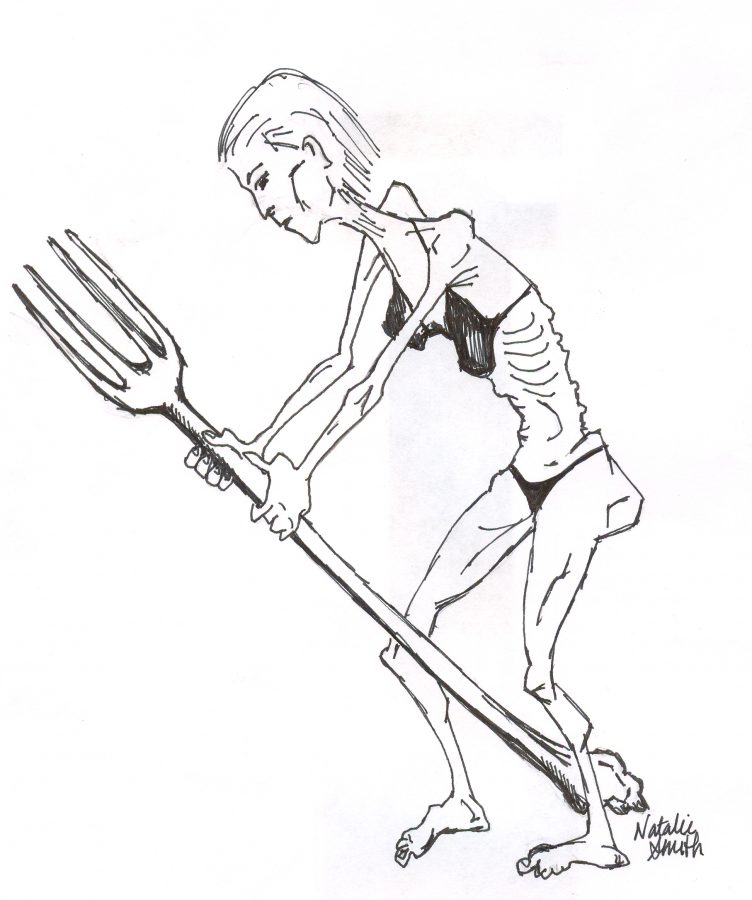Eating disorders plague teens
April 30, 2013

Though individuals often suffer under the radar undetected, eating disorders are everywhere. While both the skeletal ideal displayed in the media and the insecurity and stress of adolescence are factors, the roots reach significantly deeper in most cases, complicating recovery.
“They might be 100 pounds, but they look in the mirror, and the way they see themselves is so different than what everyone else sees,” guidance counselor Julie Kirk said. “There’s something that is causing them to think differently, and that is what needs to be reworked.”
The two primary eating disorders are anorexia nervosa and bulimia nervosa. Although both disorders involve excessive concern with body image, someone with anorexia focuses on losing weight through strict control of the amount eaten, while a person with bulimia goes through cycles of binging and purging. One out of every 200 American women currently suffers from anorexia, and two to three out of every 100 American women struggle with bulimia. An eating disorder usually emerges as a coping mechanism for some stress in the individual’s life.
“Kids might turn to drinking, drugs, self-harm, or eating disorders, which are all forms of self-medication,” Kirk said. “Most people with eating disorders might start once they are in high school because of stress or family life, and that is their control, how they cope.”
Graduate Elizabeth Bennett says her eating disorder came on gradually, but the night she discovered her parents were getting a divorce, she first tried purging. After that she began restricting her food intake and counting calories. Similarly, junior Jane Eyre’s eating issues developed in response to family stress.
“I think it started because I didn’t really have any control over anything in my life,” Eyre said. “My mom and dad used to be really strict, so it probably started so I could have something to control in my life.”
Peers might notice symptoms when a friend purges in the restroom or they witness a battle at the dinner table with parents about eating, but the disorder usually plays out behind the scenes. People with eating disorders report experiencing a continual internal dialog with their condition.
“The voice is there all the time, especially when food is around,” Eyre said. “At the beginning it felt more like a voice talking to me, but the more I got used to it, it was hard to tell which voice was me and which was the eating disorder. It’s, like, ‘you’re fat.’ So you’re, like, ‘I’ve been doing everything I can.’ And the only option is to either not eat or purge it all. It calms down for a little while.”
Teens with eating disorders report that the voice subtly intrudes as part of their thoughts and feelings, convincing-them of their worthlessness, and ensuring they don’t eat.
“You trust it because it plays on your insecurities. Since it’s in your head already, it knows what you’re insecure about, what you’re paranoid about,” Eyre said. “It tells you stuff like, ‘If you take even one bite, you will gain 20 pounds. You will have failed yourself. You will have ruined your life. You’re disgusting.’”
Food becomes an obsession, and in many cases, the calories of all the food eaten in a day are accounted for. As the disorder progresses, the quantity of food consumed decreases, and the body begins to starve.
“I don’t want to be super underweight,” Bennett said. “I want to lose some weight, but not a lot. So I tell myself, ‘It’s fine, you just lose that much weight, then you’ll stop.’ But once you reach that point, it’s not going to stop there.”
The disorder advances like a virus, polluting almost every aspect of the victim’s life. As the symptoms become overwhelming, the person often feels hopeless and out of control.
“It can definitely feel like it’s consuming my life,” Eyre said. “It feels like your insides, like in your chest, there’s a big black pit, but it hurts somehow and it’s sucking at you, and the only thing that stops it is throwing up or exercising. There was a period of time where I would literally stay up all night just exercising when I felt too guilty of what I was eating.”
Often people with eating disorders forcibly resist attempts from loved ones to help them recover, leaving family members frustrated and hurt. The affected person becomes convinced that people trying to hinder the disorder, their control, are their adversaries.
“Parents can make it worse by constantly picking at their child about the same thing,” Kirk said. “Depending on the severity, there are times when you have to go into your child’s room and make sure they are not throwing up into a bag, make sure they’re not hiding dinner, escort them to the bathroom to make sure they are not throwing up, but constantly barraging them − that’s probably the worst thing any family can do because it’s a symptom. The real problem is something else that they need to figure out.”
People with eating disorders often seclude themselves from life and plan their days around the disorder.
“It’s like you don’t even care anymore,” Eyre said. “I was so obsessed about my eating disorder, I didn’t have time for [people I really care about] anymore. I wanted to be by myself all the time. I would plan my whole day around when I can purge and stuff. I couldn’t even function.”
Eating disorders can hinder relationships since the illness often is not something that the person wants a partner or friend to know about.
“It’s such a huge part of my life that it’s hard to hide it, so I avoid dating altogether,” Eyre said. “I dated this one guy, and I finally told him after two months because I was doing really badly and throwing up all the time. When I told him, he started making horrible jokes about people with eating disorders, so I was like ‘never again’.”
The numerous physical effects of an eating disorder may cause harm to one’s body that might never go away. The body begins to eat its muscle when it doesn’t have food to run on, and normal body functions are impaired. More people die of eating disorders than from any other mental illness, often due to heart failure. The mortality rate for people diagnosed with anorexia is approximately 20 percent.
“Over a long period of time, [eating disorders] make your body sick, just sick, because it’s not getting what it needs; it can’t just keep going,” school nurse Denise Moravitz said. “You can’t have normal muscle regeneration, bone regeneration, or skin cell regeneration. You’re getting a buildup of all these waste products, toxicities, and your body can’t handle it. You start getting organ failure, heart failure, kidney failure, and liver failure. ”
Studies reveal that people with anorexia are 50 times more likely to die of suicide than the average person. Depression and anxiety frequently lead to eating disorders, but are also symptoms of them. Both the psychological affects and malnourishment can lead to depression.
“It feels like my brain is yelling at itself, which sounds so stupid, but it kind of takes over,” Bennett said. “There was a time when it was really bad, and I would just feel awful and be crying half the time because I felt so bad about it.”
After the disorder is discovered, a team of specialists, including therapists, doctors, and nutritionists, devise a recovery plan.
“The school lets everybody know what’s going on and helps the family make a plan,” Kirk said. “We start by talking with the student. We have to tell parents and generally get personnel involved, either a school psychologist or school social worker. The goal would be to set up outside counseling, and depending on the severity, possibly send them to an intensive inpatient eating disorder clinic; kids who leave the state are gone for months.”
Inpatient clinics ensure that patients are eating and attempt to dig to the roots of the issue. The patient receives counseling and learns techniques to deal with symptoms. In extreme cases, saving the patient’s life may involve immobilization to prevent a heart attack. After starting freshman year, Eyre was sent to a treatment center in Arizona, where she stayed for a few months.
“At first I wanted to leave. I did not want to be there at all,” Eyre said “They had really strict rules, and then the second day I got a feeding tube, but once I got close to everybody, the staff was really nice and I learned a lot. I probably would not have changed at all had I not gone. They taught me a lot about health and mind set tools you can use to help with anxiety. I also got so close to all the girls there, and we still keep in touch through texting and Facebook. “
The sooner the disorder is addressed, the greater the likelihood treatment will prove successful. Professional treatment is the only hope for recovery in many cases.
“I don’t think it’s something that just ends on its own,” Bennett said. “It’s like a psychological thing that you can’t just take medicine for, like depression. I think therapy helps.”
After returning from an inpatient clinic, the patient is monitored with a long term recovery plan. Since leaving the treatment center, Eyre has had weekly appointments with doctors, therapists, psychiatrists, and nutritionists. Though it may take many years, about 60 percent of people with eating disorders recover completely when treated appropriately. They are able to re-engage in social activities and relationships, and they regain and maintain a healthy body weight.
“There are students who don’t see it as an eating disorder because they see it as just limiting their intake of food,” Kirk said. “And maybe they haven’t gotten to the point where it’s having a negative impact on their body yet, but it’s not going to get better. It can only get worse unless you deal with the issue that you are masking.”







